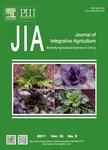Root carbon consumption and grain yield of spring wheat in response to phosphorus supply under two water regimes
Root carbon consumption and grain yield of spring wheat in response to phosphorus supply under two water regimes作者机构:Department of Resource and Environmental Science Agronomy College Shihezi University State Key Laboratory of Grassland Agro-ecosystem Institute of Arid Agroecology School of Life Sciences Lanzhou University Institute of Wheat Gansu Academy of Agricultural Sciences
出 版 物:《Journal of Integrative Agriculture》 (农业科学学报(英文版))
年 卷 期:2016年第15卷第7期
页 面:1595-1601页
核心收录:
基 金:supported by the National Nature Science Foundation of China (31300328, 31200335, 31470496) the "111" Program from State Administration of Foreign Experts Affairs (SAFEA) & Ministry of Education (MOE), China (2007B051) the Fundamental Research Funds for the Central Universities, China (lzujbky-2012-97, lzujbky-2015-ct02, lzujbky-2016-86) the funding from the State Key Laboratory of Grassland Agro-ecosystem in Lanzhou University, China
主 题:grain yield phosphorus supply rootcarbon consumption spring wheat water supply
摘 要:In semiarid areas, cereal crops often alocate more biomass to root at the expense of aboveground yield. A pot experiment was conducted to investigate carbon consumption of roots and its impact on grain yield of spring wheat (Triticum aestivum L.) as affected by water and phosphorus (P) supply. A factorial design was used with six treatments namely two water regimes (at 80–75% and 50–45% ifeld capacity (FC)) and three P supply rates (P1=0, P2=44 and P3=109 μg P g–1 soil). At shooting and lfowering stages, root respiration and carbon consumption increased with the elevate of P supply rates, regardless of water conditions, which achieved the minimum and maximum at P1 under 50–45% FC and P3 under 80–75% FC, respectively. However, total aboveground biomass and grain yield were higher at P2 under 80–75% FC; and decreased with high P application (P3). The results indicated that rational or low P supply (80–75% of ifeld water capacity and 44 mg P kg–1 soil) should be recommended to improve grain yield by decreasing root carbon consumption in semiarid areas.



